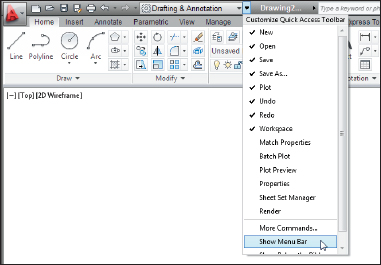Introducing the AutoCAD Drawing Commands
For descriptive purposes, I'm dividing the drawing commands into three groups:
- Straight lines and objects composed of straight lines (covered in this chapter)
- Curves (which I explain in Chapter 9)
- Points (see Chapter 9 if you're wondering what the point is)
Table 8-1 presents the most important commands for drawing 2D linear objects in AutoCAD. It lists each command by name, with the its short form, or alias (when one exists), in parentheses. The table also displays each command's graphical icon, as found on the Draw panel of the Ribbon's Home tab, and in identical form on toolbar buttons and pull-down menus in the AutoCAD Classic workspace.
Table 8-1 AutoCAD Drawing Commands for Linear Objects

If you're coming from AutoCAD 2008 or earlier, or even if you've been resisting the Ribbon in more recent releases, AutoCAD 2012's Ribbon is obviously very different from what you're used to; it's even a little different from the Ribbon in AutoCAD 2009. Like many Ribbon panels, the Draw panel has additional tool buttons on a slideout you can use once or pin so it stays open — refer to Chapter 2 for a refresher on Ribbon panels and slideouts. Similarly, many of the choices on the AutoCAD Draw menu open submenus containing several variations on each drawing command.
AutoCAD's drawing commands are highly interactive. You need to read and respond to the prompts in the command window (or at the Dynamic Input tooltip next to the crosshairs if Dynamic Input mode is turned on). You can also access many of the command options that you see in command window prompts by pressing the up- and down-arrow keys to display the options at the Dynamic Input tooltip. You can even right-click and select command options from the context-specific shortcut menu.
 AutoCAD's Dynamic Input system displays a lot of the information that you used to have to look down to the command window to see. To use Dynamic Input, make sure the Dynamic Input button on the status bar is turned on (that is, it looks highlighted). You can also press the F12 function key to toggle Dynamic Input on and off. Don't turn the command window off just yet, though — especially if you're new to AutoCAD. I recommend that you keep the command window open and docked at all times.
AutoCAD's Dynamic Input system displays a lot of the information that you used to have to look down to the command window to see. To use Dynamic Input, make sure the Dynamic Input button on the status bar is turned on (that is, it looks highlighted). You can also press the F12 function key to toggle Dynamic Input on and off. Don't turn the command window off just yet, though — especially if you're new to AutoCAD. I recommend that you keep the command window open and docked at all times.
So what's the best course: to enter drawing commands from the command line, which you can do in any workspace? Or to choose commands from the Ribbon in the Drafting & Annotation workspace, or the AutoCAD Classic workspace's menus or toolbars? Well … it all depends:
- If you've never used AutoCAD in your life: Use the Ribbon (that is, the default Drafting & Annotation workspace) rather than the toolbars and menus of the traditional AutoCAD Classic workspace. Thanks to Microsoft's clout in the user-interface world, I don't think the Ribbon is going away. I suspect more and more programs are going to adopt its look, if for no other reason than to avoid looking old-fashioned.
- If you're an experienced AutoCAD user who's been away for a release or two: Give the Ribbon a decent test drive before you switch to the AutoCAD Classic workspace. To ease your transition, you can display the classic menu bar above the Ribbon. Simply click the down arrow at the right end of the Quick Access Toolbar and choose Show Menu Bar (see Figure 8-1).

Figure 8-1: Strap on your AutoCAD training wheels with the classic menu bar.
 Whichever kind of user you are and regardless of the workspace you choose, it's a truth universally acknowledged that the most efficient way of working with AutoCAD is to use the keyboard to enter command aliases or open and close palettes. No matter how many times the graphical user interface changes, just remember that you can always use the system that's been part of AutoCAD since version 1.0 in 1982: Use the keyboard and let your fingers do the talking.
Whichever kind of user you are and regardless of the workspace you choose, it's a truth universally acknowledged that the most efficient way of working with AutoCAD is to use the keyboard to enter command aliases or open and close palettes. No matter how many times the graphical user interface changes, just remember that you can always use the system that's been part of AutoCAD since version 1.0 in 1982: Use the keyboard and let your fingers do the talking.
